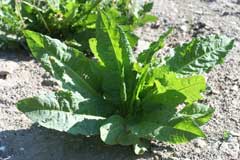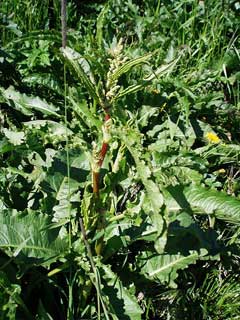 |
|
http://fr.wikipedia.org/wiki/Projet:Botanique/Accord_Henry_Brisse |
 |
| http://de.wikipedia.org/wiki/Benutzer:Jutta234 |
Translate this page:
Summary
Physical Characteristics

 Rumex longifolius is a PERENNIAL growing to 1.2 m (4ft). It is in flower from June to July. The species is hermaphrodite (has both male and female organs) and is pollinated by Wind.
Rumex longifolius is a PERENNIAL growing to 1.2 m (4ft). It is in flower from June to July. The species is hermaphrodite (has both male and female organs) and is pollinated by Wind.
Suitable for: light (sandy), medium (loamy) and heavy (clay) soils and prefers well-drained soil. Suitable pH: mildly acid, neutral and basic (mildly alkaline) soils. It can grow in semi-shade (light woodland) or no shade. It prefers moist soil.
UK Hardiness Map
US Hardiness Map
Synonyms
Rumex aquaticus. non L. Rumex domesticus.
Plant Habitats
Meadow; Bog Garden;
Edible Uses
Edible Parts: Leaves Seed
Edible Uses:
Leaves - cooked[105]. Harvested as they appear through the ground, they are eaten as a vegetable for their antiscorbutic action[2]. Seed - ground into a powder and used in gruel or added to cereal flours when making bread etc[102, 105].
References More on Edible Uses
Medicinal Uses
Plants For A Future can not take any responsibility for any adverse effects from the use of plants. Always seek advice from a professional before using a plant medicinally.
Alterative Astringent Cholagogue Deobstruent Stomachic Tonic
The whole plant, but especially the root, is alterative, astringent, cholagogue, deobstruent, stomachic and tonic[4, 21].
References More on Medicinal Uses
The Bookshop: Edible Plant Books
Our Latest books on Perennial Plants For Food Forests and Permaculture Gardens in paperback or digital formats.

Edible Tropical Plants
Food Forest Plants for Hotter Conditions: 250+ Plants For Tropical Food Forests & Permaculture Gardens.
More

Edible Temperate Plants
Plants for Your Food Forest: 500 Plants for Temperate Food Forests & Permaculture Gardens.
More

More Books
PFAF have eight books available in paperback and digital formats. Browse the shop for more information.
Shop Now
Other Uses
Dye
Although no specific mention has been made for this species, dark green to brown and dark grey dyes can be obtained from the roots of many species in this genus, They do not need a mordant[168].
Special Uses
References More on Other Uses
Cultivation details
Succeeds in most soils but prefers a deep fertile moderately heavy soil that is humus-rich, moisture-retentive but well-drained and a position in full-sun or part shade[200].
References Carbon Farming Information and Carbon Sequestration Information
Temperature Converter
Type a value in the Celsius field to convert the value to Fahrenheit:
Fahrenheit:
The PFAF Bookshop
Plants For A Future have a number of books available in paperback and digital form. Book titles include Edible Plants, Edible Perennials, Edible Trees,Edible Shrubs, Woodland Gardening, and Temperate Food Forest Plants. Our new book is Food Forest Plants For Hotter Conditions (Tropical and Sub-Tropical).
Shop Now
Plant Propagation
Seed - sow spring in situ. Division in spring.
Other Names
If available other names are mentioned here
Native Range
TEMPERATE ASIA: Russian Federation-Ciscaucasia (Ciscaucasia), Russian Federation (Dagestan), Russian Federation-Western Siberia (Western Siberia), Russian Federation-Eastern Siberia (Eastern Siberia), China (Hebei Sheng, Gansu Sheng, Jilin Sheng, Liaoning Sheng, Shanxi Sheng, Shandong Sheng, Shaanxi Sheng, Sichuan Sheng, Qinghai Sheng, Nei Mongol Zizhiqu, Ningxia Huizi Zizhiqu, Xinjiang Uygur Zizhiqu), Japan EUROPE: Denmark, Finland, United Kingdom, Iceland, Norway, Sweden, Germany (north), Russian Federation-European part (European part (incl. arctic region)), Estonia, Lithuania, Latvia, Ukraine, Spain (north), France (south)
Weed Potential
Right plant wrong place. We are currently updating this section.
Please note that a plant may be invasive in one area but may not in your area so it's worth checking.
Conservation Status
IUCN Red List of Threatened Plants Status :

Growth: S = slow M = medium F = fast. Soil: L = light (sandy) M = medium H = heavy (clay). pH: A = acid N = neutral B = basic (alkaline). Shade: F = full shade S = semi-shade N = no shade. Moisture: D = dry M = Moist We = wet Wa = water.
Now available:
Food Forest Plants for Mediterranean Conditions
350+ Perennial Plants For Mediterranean and Drier Food Forests and Permaculture Gardens.
[Paperback and eBook]
This is the third in Plants For A Future's series of plant guides for food forests tailored to
specific climate zones. Following volumes on temperate and tropical ecosystems, this book focuses
on species suited to Mediterranean conditions—regions with hot, dry summers and cool, wet winters,
often facing the added challenge of climate change.
Read More
Expert comment
Author
DC.
Botanical References
17
Links / References
For a list of references used on this page please go here
Readers comment
© 2010, Plants For A Future. Plants For A Future is a charitable company limited by guarantee, registered in England and Wales. Charity No. 1057719, Company No. 3204567.